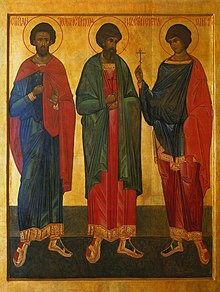| Saints Anthony, John, and Eustathius of Vilnius | |
|---|---|
 A medieval Orthodox icon of the Martyrs of Vilnius A medieval Orthodox icon of the Martyrs of Vilnius | |
| Martyrs | |
| Died | 1347 Vilnius, Lithuania |
| Venerated in | Eastern Orthodox Church Roman Catholic Church |
| Feast | 14 April |
| Patronage | Vilnius |


Anthony, John, and Eustathius (Eustathios, Eustace; Russian: Антоний, Иоанн and Евстафий, Lithuanian: Antanas, Jonas ir Eustachijus; Martyrs of Vilnius, Russian: Виленские мученики, Lithuanian: Vilniaus kankiniai) are saints and martyrs (died 1347) of the Russian Orthodox Church. Their feast day is celebrated on 14 April in the horologion.
Life
They were attached to the Grand Duchy of Moscow, and were missionaries dispatched to the court of Algirdas, who was the pagan Grand Duke of Lithuania. Algirdas was wed to the Orthodox princess, Maria of Vitebsk, and the three were permitted to minister only to her and banned from proselytizing.
The youths were later arrested for preaching in public, and were ordered by Algirdas to consume meat in his presence during an Orthodox fasting period. When they refused, they were tortured and executed.
Veneration
Their bodies were in a glass reliquary in the crypt chapel under the altar of the cathedral in the Monastery of the Holy Spirit in Vilnius, Lithuania. Their relics, said to be incorruptible, have since been moved to the main sanctuary of the cathedral.
They have also been recognised as saints in the Roman Catholic Church, after having been added to the General Roman Calendar by Pope Paul VI in 1969.
References
Literature
- John Meyendorff, The three Lithuanian martyrs: Byzantium and Lithuania in the fourteenth century // St. Vladimir Theological Quarterly, 26 (1982), 29–44
External links
- Saint of the Day, April 14: Antony (Kukley), Eustace (Nizilon), and John (Milhey)
- Martyr Anthony of Vilnius, Lithuania (April 14) at Orthodox Church in America
- Icon at Orthodox Church in America
This Eastern Orthodox Christianity–related article is a stub. You can help Misplaced Pages by expanding it. |
This article about a saint is a stub. You can help Misplaced Pages by expanding it. |